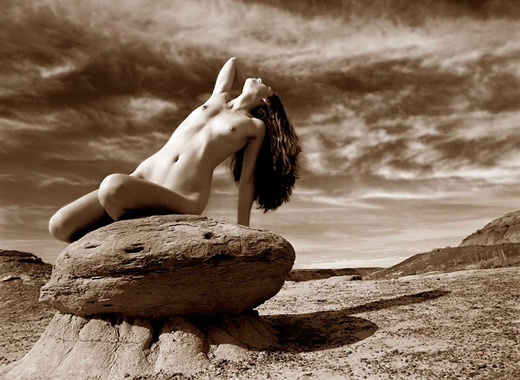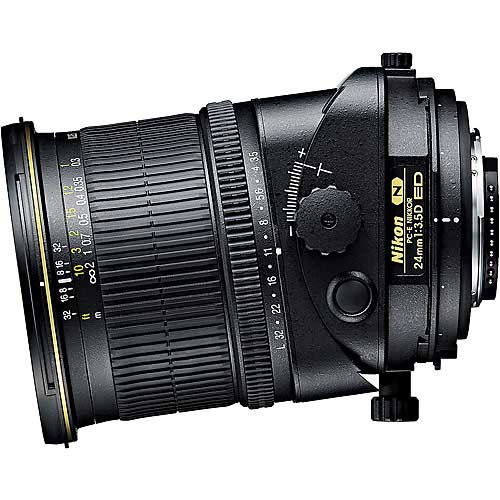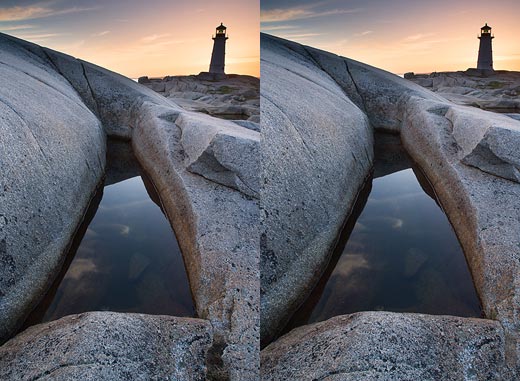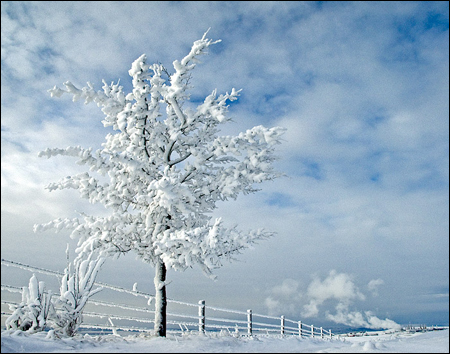Good friend to Photography.ca Darwin Wiggett is offering a workshop (about 1/2 hour west of Calgary, Alberta) on August 12–14, 2011 on how to shoot landscape nude photography, called Gaia Nudes. Darwin is a fabulous photographer and teacher so it’s my pleasure to help spread the word. Read on if you are interested in learning how to shoot nudes with Darwin and Samantha. As always, Darwin only works with small groups so spots fill up fast.

Q: What is Gaia Nudes?
A: Gaia Nudes is the name of our project for photographing artistic nudes in the landscape. As landscape shooters, we have an appreciation for natural beauty. Melding the human form into the landscape seemed a fun and challenging way to merge our appreciation of the landscape with recognition of the beauty inherent in the natural human form. The results of our work are showcased on our website, www.gaianudes.com.
Q: As you say, you are primarily nature and landscape shooters; how did you come to develop this website and concept behind Gaia Nudes?
A: Well, there are many, many wonderful landscape scenics out there online, in magazines and in other forms of publications. There are also a lot of pictures of nude or naked people online: just try searching for quality, fine art nude photography and you are inundated with what is often just soft porn! We realized that there are much fewer examples of images that combine a well-composed landscape with an artistic interpretation of the human form. We thought this would be a challenging yet rewarding way to broaden our skills as photographers.
Q: How is Gaia Nudes different from say, boudoir or glamour nude photography?
It really boils down to one key word: sex. Fine art nude photography is not there to sell a sexual idea. Sure, there is intimacy and sensuality in fine art nude landscape images, but we are appealing to these sensibilities more than we are appealing to people’s interest in sex. Boudoir photography is as its name implies: shot in a private, intimate setting with props such as sexy clothing, mood lighting, makeup and provocative postures. The emphasis is on the physical desirability of the person being photographed rather than on a general aesthetic appreciation of the figure. Glamour nudes sell sex packaged up with fashion. Both are respectable forms of expression, but they are not what Gaia Nudes is about. A Gaia Nudes shoot may show the fragility of the body when exposed to the elements, it may be a story in the contrast in textures, or it may highlight the parallel forms of the human body and its echo in the line of a tree, hillside or jagged rock.
When we are out photographing with our models, we are all having fun. We laugh at our mistakes, spin creative ideas off each other, and experiment with poses that connect the body to the landscape. It’s a physical and mental workout!
Q: Why would other photographers be interested in this area of photography?
We have heard many times from our workshop participants that they are ‘in a rut’ or bored with their photography. For shooters looking for a challenge, photographing nudes outdoors brings into play many skills and challenges, forcing photographers who think of themselves as ‘people’ shooters or ‘nature’ shooters to think outside of the box. If you enjoy photographing beauty in any form, then you would be interested in this kind of photography!
As well, because we have avoided the need to ‘sell sex’, the photographer has a much wider range of emotion and story to work with. By freeing the shooter and the model from the boudoir or bedroom, we’ve freed them to work together to channel original and unique expressions or stories.
Q: What do you look for in a landscape for a Gaia Nudes model shoot?
Good question! We look for a landscape that has a bit of mobility in terms of it can support more than one pose or idea. Ideally, a landscape that has several features of interest, such as some open land, rolling hills, some forest, perhaps some rocky terrain…. Practically speaking, we need land features that are capable of supporting safely both photographer and model (so no swamps, willow thickets or scree slopes!). Privacy is also critical so both model and photographer can concentrate. The landscape should also be something that we would photograph for its own sake. Too often when a photographer takes a model outdoors for nude work, the landscape gets short shift and is relegated to a few sticks or a rocky waterfall. We want both nature and the model to be appreciated since their stories are interwoven.
Q: What do you look for in models?
There are a few characteristics that are critical. The most important is attitude. We are seeking a fun and rewarding experience for both model and photographer, so a person with a positive attitude and a willingness to get a bit dirty or work a little harder for the shot are critical. In terms of physical characteristics, we look for a slim, fit and healthy body that looks natural. The camera appreciates models who can elongate their limbs and carry an elegant line from head to toe. We love yogis, dancers, and gymnasts for this form of work. The model should have a good kinesthetic awareness and an ability to understand a direction from the photographer so that he or she can translate a verbal suggestion into a pose. This is definitely a talent! We avoid models that are too muscular, too endowed (remember, we’re not selling sex!) or disproportional. We don’t have height requirements, we aren’t gender-biased, and we don’t really care about the model’s facial beauty since we’re not selling glamour, fashion or boudoir.
Q: Describe a typical shoot.
This is one area where we are landscape shooters, through and through! We start early (just after sunrise is best) and work in the lovely early morning light for a couple of hours. We usually break for midday both for health (heatstroke, anyone?) and then resume in the long, golden light of the evening. Each session is usually about three hours long. Both of us work one model and encourage suggestions or ideas from the model as well as each other. We rarely use supplemental light, but sometimes we share holding a reflector to brighten parts of the model’s body.
Q: What are some of the challenges and rewards of this form of photography?
The challenges of this form of photography is that it is like an ‘all over’ workout: so many skills are at play! Mentally, you need creative vision to picture a concept. You need good communication skills to translate this vision to the model so that he or she can picture what you have in mind and execute your suggestions. You also need to be flexible to respond to changing poses, other’s ideas and variable weather and light conditions. There is a bit of physical exercise too. Fine art outdoor nude photography combines skills from the traditions of both portraiture and landscape photography. The rewards are increased skill levels, compelling imagery and that satisfaction you feel when you work together as a team with your model to create an amazing image.
Q: Can you provide any tips for composing the scene?
You have to work within an idea. Just plunking a person into a scene is going to look artificial. Try and think of the model as another feature of the environment. Where would this feature look best in the overall scene? Look for shapes or elements in the scene that might mirror the shape and form of the human body, or contrast with the human form. If you are really stuck, try having your model make different forms (rounded or long, arms and limbs out or close to the body) next to another distinctive element in the scene. For example, a round rock in a prairie scene might suggest a curved form on or around the rock, or you could angle for contrast and have your model in a sitting triangular pose to contrast with the rounded form of the rock.
Lens choice and point of view are also important when composing the scene. Since this is about the landscape and the model, we often use wider angle lenses and shoot further back than traditional boudoir or fashion photography.
Q: Where do you look for inspiration on how to pose models within the scene? Is communication of your vision easy or difficult?
A lot of our inspiration comes from the landscape itself. There are always interesting shapes, textures and lines in nature that you can work with. We encourage our models to come up with ideas as well since they know what their bodies are capable of doing in terms of reach, balance etc. Communication depends each time on the relationship between the photographer and the model. We try to be very clear and descriptive with our language to translate our vision in what we want the model to do. So, instead of saying, “Can you just move that arm a bit more over there?” which is a terribly uninformative way of putting it, we would be more specific: “Can you lift your right arm about 90 degrees out from your side and bend your elbow so that your right hand rests behind your right ear?”
We have also wandered across some exceptional fine art nudes in the landscape and those are also always an inspiration.
Q: What equipment do you use in the field?
We mostly use natural light as it is very beautiful and flattering to both landscape and model if you shoot in bright overcast light or when the sun is lower in the sky. We may use a reflector for some fill, and on some occasions we break out off-camera flash with a soft box for other effects.
Q: You are also both photo instructors with eBooks and workshops on offer. I understand you have an upcoming workshop on this form of fine art photography. Can you describe that for any viewers who may be interested to learn more?
We greatly enjoy teaching, so we do have some eBooks on generic photography topics, along with our business partners Jay and Varina Patel, at www.visualwilderness.com But our Gaia Nudes work is primarily on our Gaia Nudes website. We are offering a workshop this summer, in Alberta near where we live, on how to create this form of artistic photography. The workshop takes place August 12–14, 2011 on gorgeous, private ranchland in the foothills. We have several models and a very limited number of participant spots. We’ll be covering how to communicate your creative vision, compositional tips and techniques and essential equipment, and we have a Ladies Only day specially set aside for female shooters who appreciate comraderie and company in learning new forms of photography.
Darwin Wiggett and Samantha Chrysanthou are both creative and life partners. They specialize in high-quality, accessible instruction on photographic topics. Their work has been published in both national and international magazines and publications; Darwin is a regular columnist for Outdoor Photography Canada magazine. You can read more about them by visiting their websites (www.darwinwiggett.com , www.chrysalizz.smugmug.com) or their blogs (www.darwinwiggett.wordpress.com , www.samsrant.wordpress.com)






